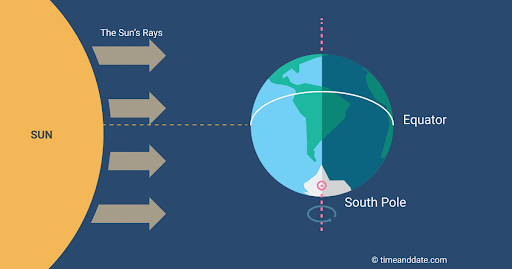Equinoxes
An equinox is an astronomical event that occurs twice a year, falling around March 21 and September 22. Perhaps you have also heard of their cousins, the solstices.
Allow me to explain. As of now, scientists have agreed that the Earth is, in fact, a sphere that revolves around a larger, fiery sphere we call the sun. We call one full revolution around the sun a year. The Earth's axis has a 23.5º tilt, so the sunlight shines at an angle to the Earth's surface, depending on the part of the world it shines on and the time of the year.
The solstices are when sunlight shines at an angle of 90º on the northmost and southmost altitudes, called the Tropic of Cancer (23.5ºN) and the Tropic of Capricorn (23.5ºS). An equinox is when the sunlight shines at a right angle at a latitude of 0º (also known as the equator).

Earth rotates at a 23.5º angle to the sun, which causes the seasons.
The September equinox marks the autumnal equinox (fall equinox) for the Northern Hemisphere and vernal equinox (spring equinox) for the Southern Hemisphere due to opposite seasons in the two hemispheres. The word "equinox" is derived from Latin, meaning "equal night." During an equinox, night and day would take around 12 hours (although they aren't exactly equal due to atmospheric refraction, which allows us to see the sun before it truly rises and sets).

During an equinox, the sun shines equally on both hemispheres
axis: The invisible line that Earth rotates around
atmospheric refraction: The way light bends as it passes through Earth's atmosphere
autumnal equinox: The fall equinox, falling on September 22 in the Northern Hemisphere and March 21 in the Southern Hemisphere
equator: An imaginary line at 0º latitude running from East to West, separating the Northern and Southern hemispheres
equinox: Period in which day and night are nearly equal and in which sunlight shines at a right angle on the equator
revolution: An orbit around the sun or other celestial body
solstice: Astronomical event in which the day or night is longest and in which sunlight shines at a right angle at 23.5º north or south
vernal equinox: The spring equinox, falling on March 21 in the Northern Hemisphere and September 22 in the Southern Hemisphere

Content Created by kiwiiibird
Content Designer: JJiawei
Source:
https://www.nationalgeographic.org/encyclopedia/equinox/#:~:text=An%20equinox%20is%20an%20event,amounts%20of%20daytime%20and%20nighttime.
Image sources:
https://www.timeanddate.com/astronomy/seasons-causes.html
https://www.timeanddate.com/calendar/september-equinox.html
Bạn đang đọc truyện trên: Truyen247.Pro